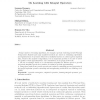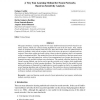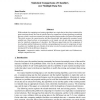TAL
2010
Springer
14 years 5 months ago
2010
Springer
Mihalcea [1] discusses self-training and co-training in the context of word sense disambiguation and shows that parameter optimization on individual words was important to obtain g...
JMLR
2010
14 years 5 months ago
2010
A large number of learning algorithms, for example, spectral clustering, kernel Principal Components Analysis and many manifold methods are based on estimating eigenvalues and eig...
ML
2007
ACM
14 years 6 months ago
2007
ACM
We offer a new formal criterion for agent-centric learning in multi-agent systems, that is, learning that maximizes one’s rewards in the presence of other agents who might also...
ML
2008
ACM
14 years 7 months ago
2008
ACM
It is well-known that heuristic search in ILP is prone to plateau phenomena. An explanation can be given after the work of Giordana and Saitta: the ILP covering test is NP-complete...
108
click to vote
JMLR
2006
14 years 7 months ago
2006
This paper introduces a learning method for two-layer feedforward neural networks based on sensitivity analysis, which uses a linear training algorithm for each of the two layers....
JMLR
2006
14 years 7 months ago
2006
While methods for comparing two learning algorithms on a single data set have been scrutinized for quite some time already, the issue of statistical tests for comparisons of more ...
CSL
2007
Springer
2007
Springer
Speaker-adaptive learning of resonance targets in a hidden trajectory model of speech coarticulation
14 years 7 months ago
A novel speaker-adaptive learning algorithm is developed and evaluated for a hidden trajectory model of speech coarticulation and reduction. Central to this model is the process o...
ICML
2010
IEEE
14 years 8 months ago
2010
IEEE
This paper experimentally evaluates multiagent learning algorithms playing repeated matrix games to maximize their cumulative return. Previous works assessed that Qlearning surpas...
IJCAI
1989
14 years 8 months ago
1989
Despite the fact that many symbolic and connectionist (neural net) learning algorithms are addressing the same problem of learning from classified examples, very little Is known r...
IJCAI
1989
14 years 8 months ago
1989
Several published reports show that instancebased learning algorithms yield high classification accuracies and have low storage requirements during supervised learning application...




